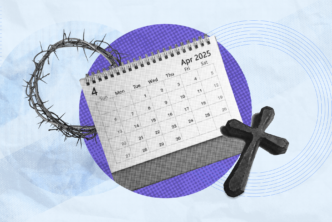In many Christian traditions (Catholic, Lutheran, Methodist, Anglican and Presbyterian), this Wednesday marks the first day of Lent. For 40 days, observers everywhere will be forsaking things like meat, chocolate, or television—all in preparation for Easter. But why 40 days? What is Lent all about? We’ll dig into the history as well as provide several powerful resources for Lent.
Origins of Lent’s 40 days
The tradition echoes Jesus’ fast during his 40 days and nights in the desert (Matt. 4:1-2), where he endured temptations offered by the devil himself. In that extreme climate, Jesus went without a bite to eat for more than a month. He must have been ravenous when the devil found him. And the theme of the first temptation? Bread (Matt. 4:3). After resisting the devil three times, Jesus banished him and went on to begin his public ministry, the culmination of which was his death on cross. Lent is a time of penance, prayer, and reflection as we contemplate Jesus’ ultimate gifts: his sinless life as a sacrifice for our sins, and his triumph over death.
The Hallmarks of Lent
Lent has many themes, but the three major motifs are denial, prayer, and reflection.
In honor of Christ, denial is exercised very intentionally during Lent. Jesus’ very life on earth was an example—he denied himself his incarnate form, humbling himself to walk among us, obedient to the point of death (Php. 2:5-8). And from the pages of the Bible he asks us to deny ourselves, take up the cross, and follow him (Matt 16:24). The self-denial associated with Lent helps focus our thoughts on him.
Focusing thoughts on God can easily give way to prayer and reflection. Jesus reveals the importance of prayer through example (Luke 6:12) and beseeches us to pray using parables (Luke 18:1). Through prayer and seeking God, Lent observers prepare for Easter by reflecting on why we celebrate it:
For to this you were called, because Christ also suffered for you, leaving you an example, so that you should follow in his footsteps, who did not commit sin, nor was deceit found in his mouth, who when he was reviled, did not revile in return; when suffering, he did not threaten, but entrusted himself to the one who judges justly, who himself bore our sins in his body on the tree, so that we may die to sins and live to righteousness, by whose wounds you were healed. (1 Peter 2:21–22)
Fifty Reasons Why Jesus Came to Die by John Piper
John Piper gathers 50 New Testament answers to the most important question faced by believers: What did God achieve for us in sending his Son to die? This book will help you reflect on the true meaning of Christ’s sacrifice.
Jesus and the Victory of God by N. T. Wright
N. T. Wright pens a compelling account of how Jesus himself understood his mission as the divinely ordained fulfillment of Israel’s destiny.
The Murder of Jesus by John MacArthur
John MacArthur tells the story of Christ’s sacrifice, with special attention to Jesus’ words on the cross, the miracle that attended the Crucifixion, and the true meaning of Christ’s atoning work.
You might also want to take a look at the following powerful titles:
- The Truth of the Cross, R. C. Sproul
- The Radical Cross, A. W. Tozer
- The Trial and Death of Jesus Christ, James Stalker
- Jesus: The Final Days, Craig A. Evans, N. T. Wright, Troy A. Miller
- The Crown and the Fire, N. T. Wright
- The Death of the Messiah, from Gethsemane to the Grave (2 vols.), Raymond Edward Brown




